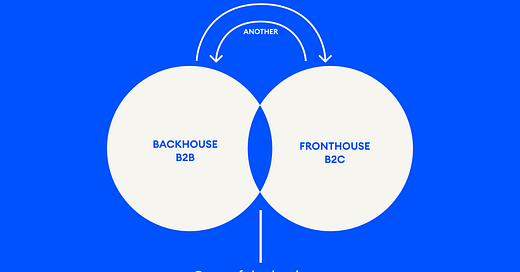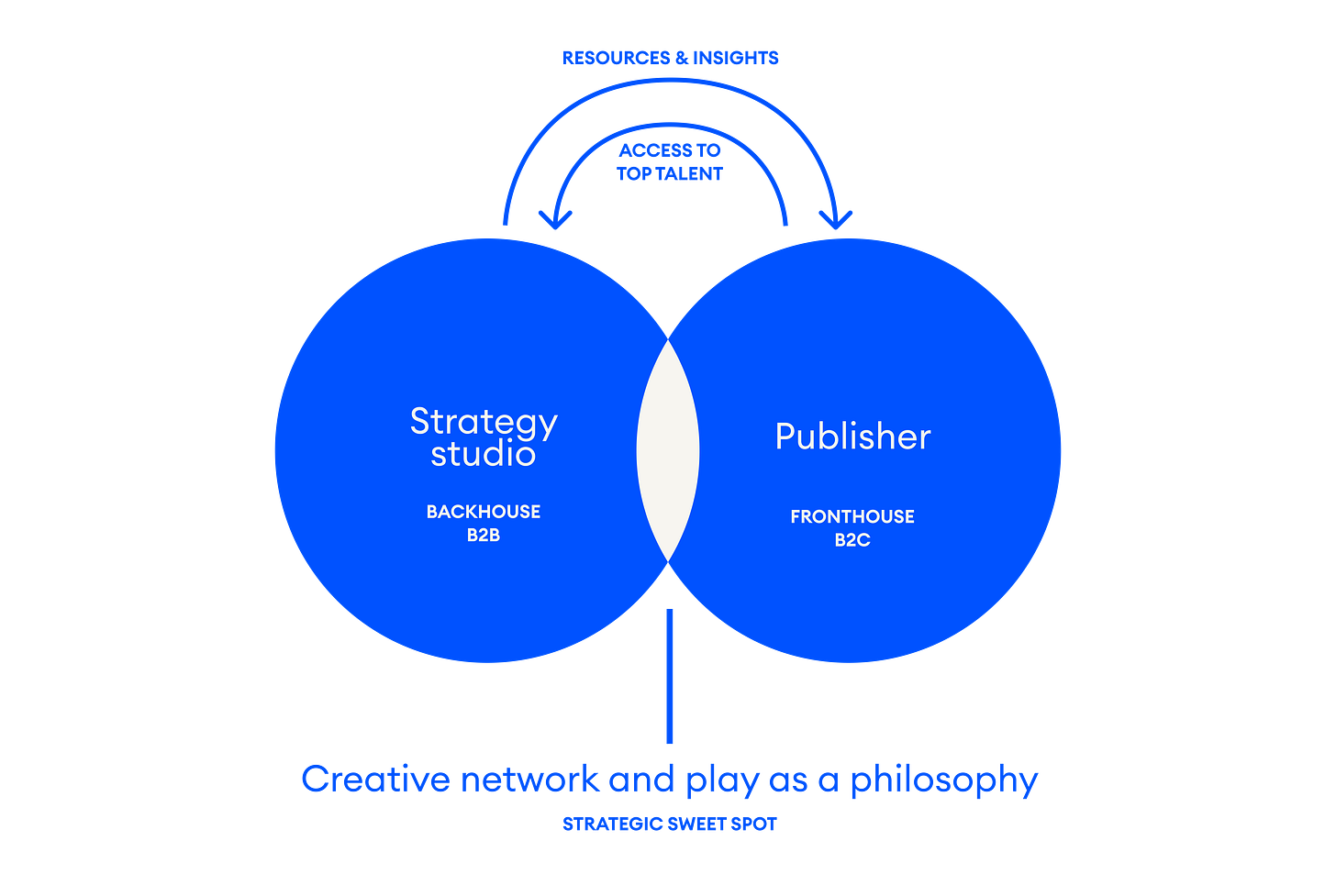Insights: a fresh take on modern creative business models
backhouse vs. fronthouse and how to find synergy
Playground readers,
Somewhere between my lunch break at a local café and the lesser-mentioned side gigs, I started noticing a new pattern in many businesses. It hooked me, and I’ve been testing this theory in my mind for months. That is — many modern brands are more than they seem — operating on two levels: a ‘backhouse’ and a ‘fronthouse.’
This concept evolved into a useful tool for thinking — helping to frame brand strategy as a Venn diagram where creativity and commerce intersect. At its core, it comes down to how modern businesses and creatives blend their passion with their commercial strategy, often running both B2B and B2C models. More importantly, it’s about understanding what makes money versus what captures an audience — and how the two can strategically fuel each other.
Let’s look at a few examples through the ‘backhouse’ vs. ‘fronthouse’ lens.
Think about businesses that operate on two fronts:
A catering business that also runs a café
A boutique events agency that doubles as a flower shop
A coffee roaster that also runs a café
A writing workshop that also operates a bookstore
A film production company that also owns a streaming platform
In these cases, the ‘backhouse’ (B2B) focuses on high-value services and industry-facing work, while the ‘fronthouse’ (B2C) creates an accessible brand presence and engages the wider audience.
But this lens can be flipped (and probably sounds ‘sexier’ this way):
A café that expands into catering
A florist that launches an events business
A bookshop that hosts writing workshops
A streaming service that builds an in-house production studio (such as Netflix, Apple TV+, Disney, etc.)
See how just by repositioning the perspective, the business model can feel completely different?
The strategic sweet spot, though, lies in the synergy — how these two sides reinforce each other.
So let’s look at a few examples.
Example one: Netflix
Netflix is widely recognised as a streaming service (B2C), but behind the scenes, they are also a movie production company (B2B).
Netflix’s Business Model:
Backhouse (B2B): Producing original content → Industry influence, ownership of IP, and strategic market positioning
Fronthouse (B2C): Streaming platform → Subscription-based revenue, audience engagement, and global reach
Strategic Sweet Spot:
By producing their own films, Netflix controls their content pipeline, builds award-winning productions, and strengthens their brand both within Hollywood and among consumers. Their content production supports their streaming platform, while their platform gives their productions an audience.
In this case, their strategic sweet spot is their most engaged audience — movie lovers. Not just casual viewers, but those who deeply care about directors, narratives, and industry trends. Imagine if Netflix identified its top 0.1% of film enthusiasts and:
Included them as extras in films
Offered exclusive set visits for upcoming productions
Gave them early access to screenings
This would create relatability, loyalty, and a deeper connection between the brand and its most engaged audience.
Example two: a fictional flower shop
Ever walked into a gorgeous flower shop that’s only open Thursday-Saturday from 12:00-16:00 and thought, How does this work financially?
What looks like a simple shop might actually be a high-end events and decorations design studio.
Floral Business Model:
Backhouse (B2B): Events and decorations consulting → Event planning & managing services with corporate and private clients
Fronthouse (B2C): A flower shop → Engages local customers, builds brand presence, and generates passive revenue showcasing it’s creativity to full extend
Strategic Sweet Spot:
Positioning the shop as a ‘living portfolio’ — a space that attracts both casual buyers and potential high-end projects.
A smart way to bridge the two could be through storytelling in the shop itself. Imagine if certain floral arrangements were labelled with their intended event — "These tulips were featured in last weekend's wedding at The Grand Hotel"— subtly showcasing their event expertise while selling everyday bouquets. Or suggest simple and quick ways to decorate at home with flowers — for dinner parties, or even bigger events, in this way tapping into B2C, but also B2B audiences, that can turn into consulting clients.
Example three: studio playground (us!)
Let’s look at ourselves.
Backhouse (B2B): We are a strategy studio, helping businesses, brands, and projects play the long game through aligned initiatives and strategy
Fronthouse (B2C): We run an independent print magazine
Strategic Sweet Spot:
You’d be shocked how many people know only one or the other. Last year, we struggled to nail the synergy between the two, but the middle part was clear from the get go — creative network and play as a philosophy.
To run a great consultancy, we need access to top talent. To attract talent, we need to engage with the creative community. Our magazine acts as both a talent pipeline and a space to experiment, and talk the manifesto and visions we believe in.
Also, many strategy studios are seen as boring — we want to challenge that, and play the role it deserves. (Side note: hope you start seeing this unfold more and more with the content we have planned for you!)
Finding synergy in your business
Running a dual-offer business is about finding the synergy. You need to dig deep, see both sides together, and understand what sits in the middle. Usually, it’s something fundamental — a philosophy, a passion, a core idea, audience, that connects them.
To summarise:
The backhouse is the engine — it may be where the money is made, even if it’s not the most visible part of your brand
The fronthouse is what engages your audience — it may not be the most profitable, but it builds community, brand affinity, and cultural relevance
The real magic lies in the space between the two — where business strategy meets creativity
And while I focused on B2B vs. B2C examples, the opposite can also be true. Your backhouse might be B2C, and your fronthouse B2B (rare, but possible). Or they might even sit in the same category.
Ultimately, the backhouse is the engine that allows the fronthouse to exist. One fuels the other, and the other leaks back into it.
Together, they form a modern creative business model — but more than that, they offer a new way to approach strategy.
How Can You Apply This?
No matter the size of your business, one can ask yourself:
What’s your backhouse? The foundational work that keeps your business running?
What’s your fronthouse? The part that engages your audience and builds your brand?
What’s the secret synergy between the two? How can they strategically fuel each other?
If someone asked me what art in business and strategy looks like, I’d say: balancing these two is truly artful.
Added bonus — AI prompt for experimentation
Decided to experiment myself, and give you an AI prompt to play with. I still don’t think AI gets strategy, and it gives bland examples, but even some notes can sometimes help to think and look at your business differently.
You can play around and try to use this AI prompt to generate insights:
AI Prompt:
"My business is [describe your business]. The backhouse (B2B) focuses on [describe your high-value, behind-the-scenes work], providing [explain the core value it brings]. The fronthouse (B2C) engages customers through [describe your customer-facing element], offering [explain the value it creates]. What’s the strategic synergy between the two? Give me 5 possible ways they can fuel each other and uncover valuable insights."
Note, it might also be that you know what your backhouse is but want to figure out the best approach for the fronthouse — or the opposite, where you know your fronthouse but need to understand the backhouse, and then again, how both walk the walk together. Play around!
Our studio’s work and contacts can be found here.
Hope you enjoy this one,
Austė & Playground team













Love it, simple and clear
i love this